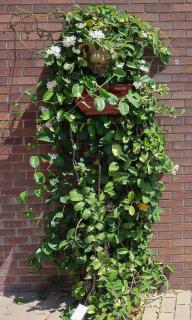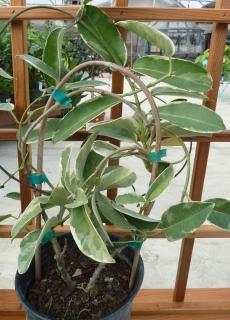Stephanotis pruning is not overly difficult, and it’s certainly nothing to be afraid of. It will help rejuvenate your plant, keep it small, and bloom closer to where you wish it to!
Here is:
- when to trim
- tools to use
- and how to prune
your Stephanotis plant. Applies to potted Madagascar jasmine and to Stephanotis trained along a wall.
When to prune Stephanotis
Best time to prune a Stephanotis vine
The best time to prune your stephanotis is at the end of winter, or the very beginning of spring.
- In the Northern hemisphere (Canada, United States, Great Britain, India…), this is around the end of February.
- In the Southern hemisphere (Australia, New Zealand, South Africa…), this is early September.
At this stage, the plant is still dormant but rising temperatures and, more importantly, daylight time will trigger quick budding and regrowth.
- Dormancy is induced by shorter days and cooler temperatures.
- In hot climates closer to the equator, dormancy isn’t as marked. In this case, best is to prune when the flowering is over.
Also, cutting at this time means the plant hasn’t yet prepared its flower buds. Indeed, these usually appear late in spring, on new growth.
- Pruning early on in spring will protect the year’s blooming.
- Stephanotis only flowers on new growth.
Circumstances when Stephanotis requires pruning
- Maintenance pruning – every year, usually starting when the plant has filled its treillis or lattice. The goal is to keep the plant from turning into a monster. Instead, it will fill its lattice in neatly and without overloading it.
- Size reduction – An overgrown stephanotis must be reined in. Depending on how large it is, this might be done in stages.
Tools needed to for pruning Stephanotis
Basic tools are needed, depending on how old your plant is and what you intend to do.
- In every case, remember to disinfect your tools with rubbing alcohol, methylated spirits, or cheap clear, high-alcohol content spirits.
- Do this before and after pruning each plant. This helps avoid spread of plant diseases.
Tools for maintenance pruning and/or young plants
- Simple pruning shears or a secateur are perfect.
Tools for Stephanotis size reduction
Plants over 5 years old tend to develop thick stems.
- Stems under 1 inch (2½-3 cm): pruning loppers + secateur
- Stems thicker than 1 in (2½ to 3 cm): small handsaw + secateur
How to prune Stephanotis
Basic maintenance pruning
 Usually, Stephanotis vine is grown along a lattice or trellis. To keep it from overgrowing the lattice, maintenance pruning is required
Usually, Stephanotis vine is grown along a lattice or trellis. To keep it from overgrowing the lattice, maintenance pruning is required
- Select several main stems that are evenly spread out along the lattice. These will be the “structural” stems.
- Cut back any side shoots emerging from these stems, back to about 3-4 inches (8 to 10 cm) out from the main stems.
- To make selection easier the next year, mark the structural stems with a ribbon, yarn or ornament. This will make pruning quicker.
- After a few years, you won’t need the ribbons anymore. Indeed, the structural stems will have grown very thick (several inches, up to 10 cm).
You may want to favor 1, 2 or 3 main stems, depending on the trellis.
- For a tall, thin trellis, a single stem climbing from top to bottom is enough.
- For a wider surface, try choosing the structure that will cover surface evenly.
- Check out various espalier patterns that are well-suited to walls.
- Remember that Stephanotis cannot attach itself to the wall. It needs to wind around wire or rods.
If you notice a plum-sized green fruit hanging from your vine, you can choose to let it mature on the branch. This is the fruit of the Stephanotis vine. Although it’s common in warm climates, it’s rather rare in temperate climates.
- It usually only grows on older plants, over 4 to 5 years old.
Reducing the size of a Stephanotis
If your Stephanotis is overgrown, you may want to reduce it in size.
- Don’t cut your stephanotis back to the stump in one go. There’s a high risk of killing the plant.
- Best is to thin the plant over two years.
In year one:
- Cut every other branch (every second branch) back to the trunk or main stem.
- Reduce remaining stems by half as well.
A year later:
- cut the remaining half so that all old branches are brought back to the trunk
- New branches should have sprouted from the main stem in the meantime.
- These you can form and prune more regularly to give your Stephanotis the size you wish.
If you proceed in this manner, you’ll have a much higher chance of seeing your Stephanotis survive!
Special case: Stephanotis wreath
Many Madagascar jasmine vines are sold in a wreath shape. As time passes, certain portions turn bare. Here are the tricks to get that lush, all-around wreath aspect back again.
Trimming a Stephanotis vine into a wreath
 On its own, your Madagascar jasmine will rarely sprout new stems or leaves on bare parts.
On its own, your Madagascar jasmine will rarely sprout new stems or leaves on bare parts.
The trick is to weave new growth back into the wreath to cover bare spots.
What you can also to is pinch the leading tip of the vine: it will branch out in several spots, giving you more “leafy stems” to work with.
- Pinch the tip off with your fingers or snip it with scissors.
If you have a grow light, try shining it on the bare part: light triggers sprouting. Don’t set it too close or you’ll risk burning the plant.
Once growth has started, don’t remove it in one go: slowly bring it further and further, or else the plant will realize it’s been “duped” and will drop the new growth.
Read also:
Smart tip about pruning Stephanotis
It’s a brilliant idea to start making cuttings from the freshly cut trimmings.


 Usually, Stephanotis vine is grown along a lattice or trellis. To keep it from overgrowing the lattice, maintenance pruning is required
Usually, Stephanotis vine is grown along a lattice or trellis. To keep it from overgrowing the lattice, maintenance pruning is required On its own, your Madagascar jasmine will rarely sprout new stems or leaves on bare parts.
On its own, your Madagascar jasmine will rarely sprout new stems or leaves on bare parts.
My fruit matured, turned brown & opened to expose seeds all on it’s own. Now that the seeds are gone, should I cut off the seed pod from the stem or will it fall off on its own? Thank you
For leaves that turn yellow & drop off, will new growth sprout from that leaf area? I had a nice circular wreath but now it looks lopsided. Thank you
Hello Jane, for the stem it’s up to you, honestly: in the wild, the stem would slowly dry up to the joint with the stem, and then with foul or windy weather it would fall off. Indoors, it’ll take longer to fall since there isn’t much wind (and Stephanotis hates drafts when indoors). So you can just as easily snip that pod off of the stem with a secateur (scissors are a bit too weak for this). Leave, say, a quarter-inch (1 cm) on the stem, any closer and you might tear the stem or wound it.
Regarding the wreath-like aspect, it’s rarely going to sprout new stems or leaves on bare parts. The trick is to weave new growth back into the wreath to cover bare spots. What you can also to is pinch the leading tip of the vine: it will branch out in several spots, giving you more “leafy stems” to work with. Pinch the tip off with your fingers or snip it with scissors. If you have a grow light, you can try shining it on the bare part: light triggers sprouting. But don’t remove it in one go: slowly bring it further and further, or else the plant will realize it’s been “duped” and will drop the new growth.